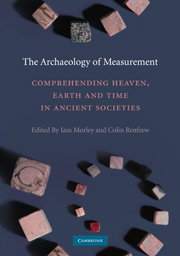Book contents
- Frontmatter
- Contents
- List of figures and tables
- List of contributors
- Acknowledgements
- The Archaeology of Measurement
- Introduction: Measure: Towards the construction of our world
- SECTION I NUMBER: COUNTING, MATHEMATICS AND MEASURE
- SECTION II MATERIALISING THE ECONOMY
- SECTION III DIMENSIONS AND BELIEF
- SECTION IV CALENDAR AND COSMOLOGY
- SECTION V THE SPIRITUALITY OF MEASURE
- Index
SECTION III - DIMENSIONS AND BELIEF
Published online by Cambridge University Press: 05 June 2012
- Frontmatter
- Contents
- List of figures and tables
- List of contributors
- Acknowledgements
- The Archaeology of Measurement
- Introduction: Measure: Towards the construction of our world
- SECTION I NUMBER: COUNTING, MATHEMATICS AND MEASURE
- SECTION II MATERIALISING THE ECONOMY
- SECTION III DIMENSIONS AND BELIEF
- SECTION IV CALENDAR AND COSMOLOGY
- SECTION V THE SPIRITUALITY OF MEASURE
- Index
Summary
Remaining initially in the Indus Valley, Section III focuses on relationships between measurement, architecture, cosmology and belief systems. Some of the key finds of the earliest excavations at the Indus Valley city of Mohenjo-Daro consisted of weight and linear measurement systems. Drawing upon his own and others' recent work at the site, Michael Jansen outlines the nature of these systems and their relations to architectural structure. These can be considered in terms of their orientation, the dimensions of their constituent rooms, and the dimensions of the bricks from which they were constructed. The bricks maintain a consistent ratio of dimensions and were made in standardised moulds, with the average size being derived from the width of the hand. There appear also to be two different orientation systems, one of which orientates to the cardinal points, although these two systems may actually be related and orientated towards different elements or periods of the same celestial system. Indeed, the ‘great ring stones’ found at the site have been identified as ‘calendar stones’, not only part of a calendrical system but also serving the function of astronomical observation instruments associated with the cosmology of the region. Jansen highlights the need for cross-site comparisons within the Indus Valley if we are to understand better the significance of the measurement and orientation systems in use at Mohenjo-Daro.
Half a world away, Saburo Sugiyama elaborates on the use of standardised measure in the creation of the architecture of the Mesoamerican city of Teotihuacan, Mexico.
- Type
- Chapter
- Information
- The Archaeology of MeasurementComprehending Heaven, Earth and Time in Ancient Societies, pp. 123 - 124Publisher: Cambridge University PressPrint publication year: 2010



